Futures in Formation: A public Art Programme
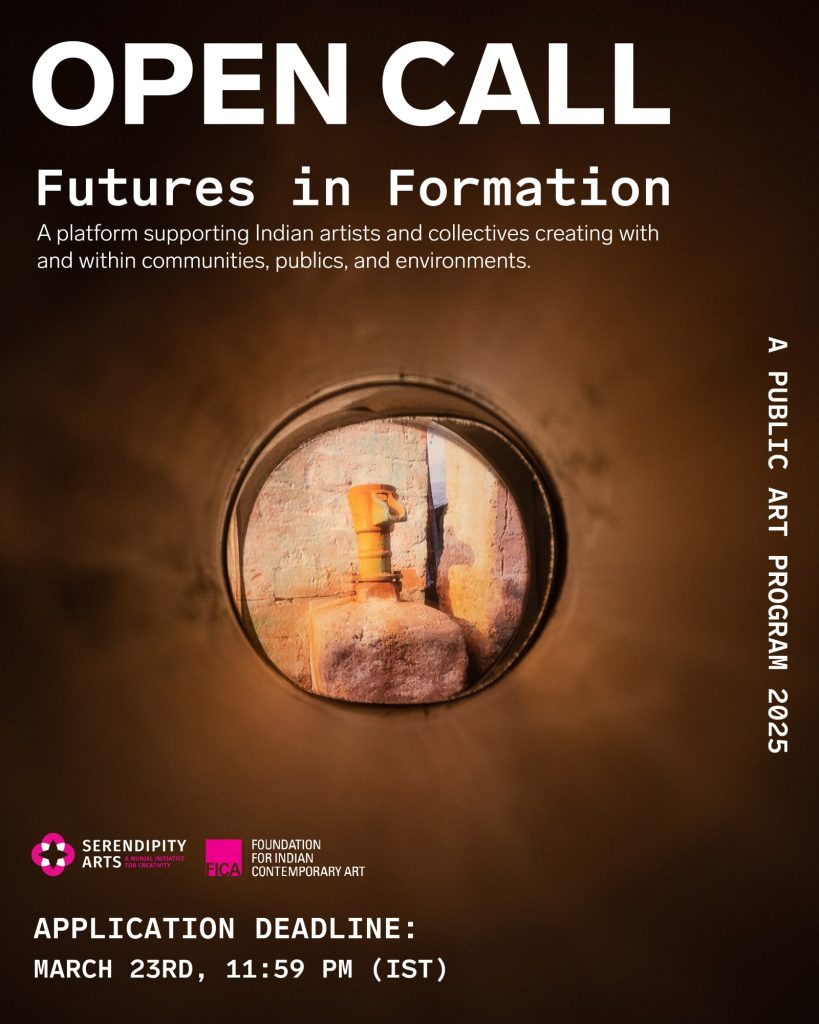
The Foundation for Indian Contemporary Art and Serendipity Arts Foundation are excited to present a new collaboration—Futures in Formation: A Public Art Programme—supporting artistic projects by Indian artists (individuals and collectives) working with a variety of publics, communities and environments.
The Programme harnesses the enthusiasm of both FICA and SAF, as institutions deeply committed to making available a significant opportunity to the field of art practice in India. It seeks to strengthen and streamline the way public art practices are put forward in the present moment. It aims to bring together critical imaginations and dialogues, siting encounters and engagements within expanded notions of what constitutes the public realm today. The program will support the development of the proposed projects through aspects of research, production, dissemination and other routes of mobilisation as required. It will entail financial support of Rs. 3 Lakh each for the project detailed in their application, to support the time period of the program (1st May 2025 to 1 March 2026).
Our shared journey of platforming public art practices
Since 2007, the FICA’s Public Art Grant has been a platform committed to supporting a wide range of public art projects, inviting experiments with the very nature of the public domain as well as with elements of site-specificity, activism, community engagement, spectatorship, participatory art and collaborative practice. The Grant has since evolved with the kinds of practices that have been inducted into its ambit, and has, over time, come to assimilate vocabularies around digitality and transience, the virtual world and invisible structures, as well as new methodologies of spatial thinking and gathering. It has also attempted to provide a space for creative practices to rethink and reformulate approaches to radical intersectionalities of caste and gender, while also programming new ways of thinking about cultural heritage, orality and history.
Through its multi-faceted grants programme as well as its annual flagship festival, SAF has remained oriented toward platforming and facilitating inventive imaginations across research and practice in the arts today. It continues to foreground the recognition of excellence and potentiality among new and existing fields of inquiry across visual, lens-based and emerging media, performing, and performance arts. Most recently, SAF’s grants for creative practice have looked at supporting and mentoring public art activations exploring ecology and land in Goa, craft and folk traditions across communities, individuals and the independent music scene, knowledge systems around food and food-based cultures, and image culture in South Asia.
FICA’s interest in exploring the spectrum of definitions around public art practices has also further grown with courses and workshops that we have conducted in collaboration with Serendipity Arts Foundation. These courses were structured to formulate methodologies and toolkits around acts of reading in the present moment; they were galvanised through processes of making geared towards critically considering what public art is responding to today. Through these spaces and modes of gathering, both institutions have worked together to collaborate with artists and practices keen to reflect on the role and texture of public art.
themes
As part of the scope of this reimagined Public Art Program, below are some themes and categories listed to help clarify its ambit as a forum. Please note that these are not watertight categories; rather, they serve as freely overlapping, possible areas of focus for interested individuals and collectives to expand on further in their proposal. We encourage proposed projects to extend across any of these (or other!) themes:
Reimagining a commons: Community and collective formations
How can public art help think about ideas of belonging, shared experiences and ways of living? Applicants are invited to think about how art in the public domain shares and amplifies the idea of community—as a concept, as a reworking of its many definitions, as practice and as a catalyst for collective identity. Projects can explore how public art becomes a space for gathering with and within notions of the commons, as well as how such formations spur, record and document conversations about different inhabitations, textures and genealogies around the same. We are interested in looking at how sustained community conversations evolve over time, and how creative practices can have a role in championing and foregrounding the dynamics of these.
Ecologies of place: Rethinking nature, urbanity, and coexistence
How can public art serve as an exploratory medium to interrogate the fluid and often contested relationships between natural and the built environments? This category invites practices to reflect on the intertwined futures of ecology and the human condition, thinking about alternative cartographies, languages and behaviours in the landscapes that surround us, and those that we inhabit. Projects can think about how we live within and move through shared environments, reconsidering routine perceptions and permeabilities. They can pay close attention to histories and vulnerabilities of a site, taking the form of works that traverse the visible and the unseen, foregrounding ecological networks, natural cycles, or the tensions between conservation and urban development. Additionally, projects can also address the convergence of physical and virtual spaces—the mediatic environments that shape contemporary life as digital spaces, screens, and virtual realities—exploring their impact on our understanding of ecology and habitation.
Sites of memory and forms of remembering in the contemporary moment
How does public art offer a dynamic space to explore the interplay between history and memory? Projects can explore new forms of storytelling that bridge the past and present, excavating forgotten, silenced, or marginalised histories, bringing them into dialogue with new discourse. By working with the textures of memory—public and private, shared and individual—they can explore different catalysts for collective reflection and cultural dialogue through creative methodologies. In the face of contemporary acts of erasure—be they political, cultural, or ecological—projects can think about how public art can serve as a form of resistance, asserting the vitality of forms of remembering that are being written out or overwritten, making space for alternate or dissenting voices in the public realm.
Cultural currents, hybridities, fusions and flows
How does public art offer a unique platform to investigate how cultures intersect, evolve, and transmit knowledge across time and space? By thinking about how dialogues between generations and communities can be fostered, public art can become a catalyst for exchange, reinterpreting traditions, practices, and histories to create new forms of shared understanding. Projects are invited to explore how knowledge is transmitted—through oral traditions, performances, rituals, or other embodied practices—while challenging conventional hierarchies of knowledge production. They can consider innovative visual and spatial strategies that respond to the vibrancy and contemporaneity of cultural hybridity. Projects can also probe deeper into how public art becomes a vital site for exploring the fluid intersections of tradition and modernity, the personal and the collective, and the local and the global, generating new forms of cultural connectivity.
The site-specific in flux
How does public art continually expand the concept of the “site,” extending beyond physical locations to include virtual, symbolic, and imagined spaces? How do sites travel or transform when uprooted from their origins, and what creative possibilities emerge from these shifts? By revisiting site-specificity, public art can explore how the meaning of a site evolves across contexts and translations. Projects in this vein can examine the fluidity of public spaces and the publics that inhabit them. They can look at the boundaries of publicness, examining how physical spaces interact with digital environments or how transient sites contribute to our understanding of public art. Projects could also interrogate the layered identities of a site—its histories, ecologies, and sociopolitical dimensions—formulating new interjections and interpretations, challenging static notions of space, while thinking creatively with what it means to inhabit, share, and reshape public realms.
Grasping accessible futures
How can public art critically engage with notions of accessibility and the lived experiences of diverse bodies? How can public art help envision accessible futures, not just in the built environment but in cultural and social spheres? This category invites projects interested in platforming the different experiences of bodies in public spaces, creating opportunities for engagement and dialogue across abilities. Projects can consider critical toolkits of awareness-building, advocacy, and storytelling, and how these may be translated into the domain of public art. They can also toy with the possibilities of art as a medium to critique, subvert, and reimagine norms that govern public spaces, offering multisensory, participatory, and inclusive modes of engagement at the crossroads of creative practice, policy, and accessibility innovation in technology and design. Projects can pursue the realities of intersectionality and belonging across a spectrum of abilities today, pushing the boundaries of what it means to inhabit and traverse shared environments.
Fellowship Ambit & Funding
- The program will support recipients with the development of their proposed public art projects through aspects of research, production, dissemination and other routes of mobilisation as required.
- It will entail financial support of Rs. 3 Lakh each for the project detailed in their application through the time period of the programme (May 2025 to March 2026).
- Recipients will be required to participate in a public forum during the course of the Program which will be discussed with them in advance. Further details on the nature of this participation will be shared post the selection process.
We invite prospective applicants (both individuals and collectives) to consider the following while applying for the Public Art Program:
Eligibility
- Individuals and collectives may apply.
- The applicant/s needs to be 18 years or older.
- The applicant/s should be an Indian citizen/s, currently residing in India.
Submission Guidelines
- The proposed project must be located in India, and the proposal must ensure adequate details on the location(s). The project can include staging across multiple sites within the country if necessary to the execution of the project. Applicants are advised to consider the feasibility of the same with regard to the program amount of Rs 3 Lakh and the program period of one year.
- The project should have the specific intention of being sited or staged in the public domain. Applicants are encouraged to reflect upon the role of public art practices, the nature of publics and public spaces today, and are free to refer to the various free-flowing categories outlined above.
- We invite interested applicants to propose projects whose creative outcomes could take various forms: From mixed and multi-media installations, community-led initiatives, tech and design , experimental archives, site-specific and traveling modules, performative interventions, alternative pedagogies and interactive design projects, to list a few.
- Modes of engagement with the public and/or any specific audiences should be clearly defined within the proposal.
- Please ensure a detailed project proposal to allow greater clarity about the potential and practicality of the project.
- Outcomes of the proposed project should be clearly defined.
- Applicants should be open to sharing their work at different stages of the program, as we imagine the scope of this platform as one that will host dialogues and conversations of various textures, bolstering the development processes for each project.
All requisite documents (listed below) must be submitted. Please read through the submission guidelines carefully before submitting your application. The project should be feasible in terms of costs and scale, and should meet the dates set in the timeline.
Timelines
Open Call: 5th Feb 2025
Application Deadline: March 23rd 2025
Program Duration: May 2025 – March 2026
Application requirements
One PDF with the following:
- Project proposal (1000 – 1500 w) with processes, engagements and outcomes clearly defined.
- A detailed budget break up of the project
- A detailed, well-explained timeline of project development.
One PDF with the following:
- Updated CV and bio. If applying as a collective, please include CVs and bios for all members of the collective.
- An updated portfolio of your individual or collective practice with not more than 15 ongoing and older projects. Please include images and open access links to video files or other supporting material within this PDF itself. If applying as a collective, please include portfolios for all members of the collective.
Please upload these PDFs to the Google Form linked below, with open access links.
Please answer all questions in the Google Form.
(Please note that applications are to be submitted only via the Google Form. Applications sent via email will not be considered.)
About Serendipity Arts Foundation (SAF):
Serendipity Arts Foundation is an organization that facilitates pluralistic cultural expressions, sparking conversations around the arts across the South Asian region. Committed to innovation and creativity, the aim of the Foundation is to support practice and research in the arts, as well as to promote sustainability and education in the field through a range of cultural and collaborative initiatives. The Foundation hosts projects through the year, which include institutional partnerships with artists and art organizations, educational initiatives, grants and outreach programmes across India.
About The Foundation for Indian Contemporary Art (FICA):
The Foundation for Indian Contemporary Art (FICA) is a non-profit organisation that aims to broaden the audience for contemporary Indian art, enhance opportunities for artists, and establish a continuous dialogue between the arts and the public through education and active participation in public art projects and funding.
FAQs
Q: My project proposal has already received a grant, am I eligible to apply?
Yes, the Programme is also open to projects that have already received support in the past. Applicants are requested to submit details regarding previous funding and support that they may have received.
Q: If I am a citizen of India, by practice outside of the country, am I eligible to apply?
No, you must be a citizen of India and currently reside in the country to be eligible for the Programme.
Q: Is there an age criteria for the Programme?
The Programme is open for applicants 18 years and above
Q: If the proposed project is in collaboration with a curator or institution, am I eligible to apply?
The project can have additional collaborators. Applicants are required to mention all details regarding collaborators as part of their application and their proposal.
Q: If a proposed project has already been shown in any form as part of a public forum, will I be eligible to apply?
The programme is open to supporting ongoing work or work that has been previously shown as part of public forums. However, applicants are required to mention all details regarding the same for the jury to better understand the scope of their current proposal.
Q: What are the artistic mediums accepted for the Programme?
The programme accepts a wide range of artistic mediums, including painting, drawing, printmaking, sculpture, ceramics, photography, video, filmmaking, architecture, sound and music, design, crafts, installations, performance, literature, and oral history.
Q: What are the kinds of creative outcomes that one can propose for the Programme?
We are interested in outcomes that have the specific intention of being sited or staged in the public domain. Applicants are encouraged to reflect upon the role of public art practices, the nature of publics and public spaces today as well as what their proposed project is responding to. Outcomes can include mixed and multi-media installations, community-led initiatives, documentation projects, video works, experimental archives, site-specific and traveling modules, performative interventions, forays into alternative pedagogies and interactive design projects, to list a few.
We encourage applicants to propose outcomes that have the potential to be presented in a public-facing festival format. This means considering aspects such as feasibility, adaptability, and mobility of the work, ensuring that it can travel and be exhibited if the opportunity arises.
Q: Do I need to be an Indian citizen to be eligible for the Programme?
Yes. You must be an Indian citizen to be eligible for the fellowship. NRI, OCI and POI
Q: Does it have to be a new project? What if I want to re-work on a previous one? Can I have funding from another organisation as well?
The programme is open to supporting new projects as well as ongoing work, as long as the proposed project comes within the ambit of themes explored within its scope. In the case of projects that are currently receiving funding from other organisations/platforms, applicants will be required to mention how this additional funding would be utilised and the specific aspect of the project they wish to utilise it for.
FUNDING & SUPPORT
Q: What is the amount for selected projects?
Each selected project will receive up to 3 Lakhs.
Q: What can the amount cover?
The amount can be used to cover various aspects, including artist honorarium, research processes, production and fabrication as well as collaborations that the applicant may wish to undertake within the scope of their proposed project.
Q: Will there be additional support apart from the financial aspect of the Programme?
Yes, selected participants will receive additional support in the form of mentorship opportunities, interactive sessions and the opportunity to participate in public facing forums.
APPLICATION & REVIEW PROCESS
Q: What is the selection process for the Programme?
The selection of the final projects will involve a jury process with independent experts from the field, and the organisations involved. Shortlisted submissions will be invited for an online interview round, and the selected projects will be announced by April 2025.
Q: What should be included in the application material?
Applicants will be required to fill a Google form with requisite information. The following are documents necessary for a completed application:
I) One PDF with the following:
- Project proposal (1000 – 1500 w) with processes, engagements and outcomes clearly defined.
- A detailed budget break up of the project
- A detailed, well-explained timeline of project development.
II) One PDF with the following:
- Updated CV and bio. If applying as a collective, please include CVs and bios for all members of the collective.
- An updated portfolio of your individual or collective practice with not more than 15 ongoing and older projects. Please include images and open access links to video files or other supporting material within this PDF itself. If applying as a collective, please include portfolios for all members of the collective.
Q: Can applicants propose more than one project?
A: Applicants are encouraged to stick to one project proposal.
TIMELINE & DELIVERABLES
Q: What is the duration of the Programme?
The time period of the Programme will be 1st May 2025 to 1 March 2026.
Q: What are the project expectations and deliverables?
Selected projects will be expected to present their proposed project as specified in their applications. The nature of this presentation or sharing will be discussed following the selection process. Fellows will also be expected to participate in mentorship sessions and public facing forums through the period of the programme. We encourage applicants to propose outcomes that have the potential to be presented in a public-facing festival format. This means considering aspects such as feasibility, adaptability, and mobility of the work, ensuring that it can travel and be exhibited if the opportunity arises.
JURY
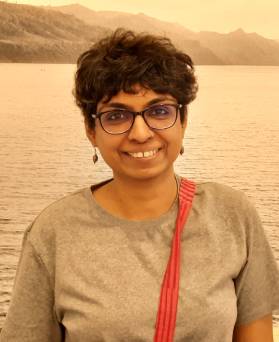
Noopur Desai is a researcher at Asia Art Archive in India, New Delhi, where she leads digitisation projects focused on personal archives and cultural journals. She is the associate editor of Primary Documents: South Asia, a forthcoming anthology with MoMA. Noopur also co-founded Hakara Journal, a bilingual platform for creative expression (2017–2022). She holds a Ph.D. in Cultural Studies from TISS, Mumbai, and is a guest faculty at Ambedkar University, Delhi.
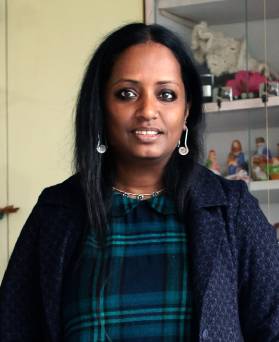
Mithu Sen is a conceptual artist whose performative practice explores myths of identity and their intersections with social, political, economic, and emotional structures. Working across media—drawing, poetry, performance, video, and text—Sen challenges hierarchies and conventions, especially those rooted in language, sexuality, markets, and marginalisation. Her works have been presented at major international platforms including Sharjah Biennale 15, APT9 Brisbane, Guggenheim Museum New York, and a 2023 survey show at ACCA, Melbourne. She is the recipient of the Skoda Prize (2010) and the Prudential Eye Award for Drawing (2015).
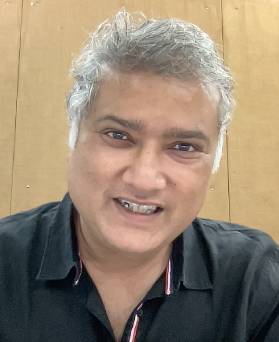
Urbanist, educator, and researcher, Prasad Shetty is the Dean and co-founder of the School of Environment and Architecture, Mumbai. His work explores the dynamic relationship between urban form and life through experimental pedagogy, collaborative research, and critical design. Shetty’s practice spans installations, exhibitions, and city-readings across Manifesta, Venice Biennale, Seoul Biennale, and MAAT Lisbon, among others. He is also co-founder of CRIT and Bard Studio, and has contributed to landmark projects on Mumbai’s evolving urbanisms.
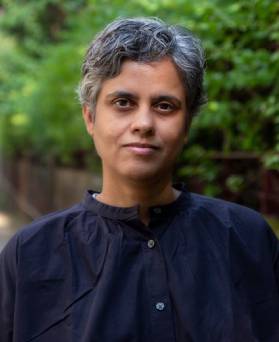
A curator and arts educator based in New Delhi, Vidya Shivadas is the Director of FICA and has curated widely at institutions including Vadehra Art Gallery, Devi Art Foundation, Kiran Nadar Museum of Art, and Serendipity Arts Festival. Her practice is deeply rooted in critical art discourse, pedagogy and institutional frameworks. Shivadas has been visiting faculty at School of Cultures and Creative Expression, Ambedkar University Delhi since 2014.
GRANTEE
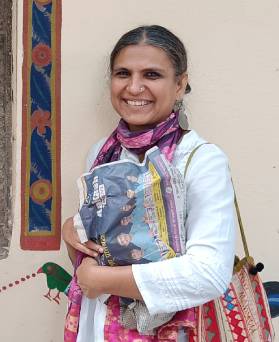
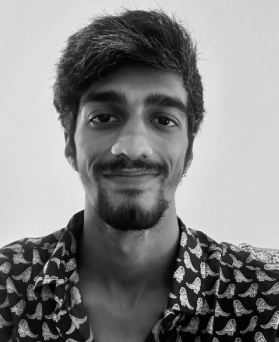
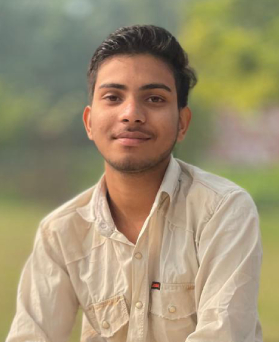
Pooja Dhingra, Achal Dodia and Hariom Srivastav
Rooted in Rafooghar / گھر or The House That Mends—a community space in New Delhi, countering the social exclusion faced by women and young girls—Meethi Baradari foregrounds a uniquely important pairing and form of dialogue: women who mend, and young boys from Shaheen Bagh, Madanpur Khadar, and Jasola who are learning to listen, stitch, and reflect.
Rafooghar draws from the word Rafoogar/ Rafu Gar, needle-worker, darner or a cloth mender and is imagined as a space for peaceful gathering. Women, who are often denied rest, gather here for sukoon (peace) and fursat (leisure), to sit together and share their stories through the mediums of embroidery and textilework. Rafooghar is part of a broader initiative, called Compassion Contagion, an online archive documenting acts of compassion and hope through art and graphic narratives.
Futures in Formation is excited to be supporting Meethi Baradari in its attempt to create a shared, empathetic space for boys to challenge and reimagine the rigid norms of masculinity we tend to inherit. By listening to women’s stories, reflecting on their own identities and relationships, and engaging with the mediums of embroidery and textiles—traditionally associated with women—the project hopes will be able to express freely, question gender stereotypes, break down rigid gender barriers, and pave the way for new dialogues and partnerships based on mutual respect and understanding. Meethi Baradari is inspired by Hariom’s story and courage.
Hariom Srivastav is a young boy at Rafooghar who loves to stitch, and continues to bravely challenge the societal pressures of masculinity.
Achal Dodia is an artist, educator, and facilitator whose multidisciplinary practice explores the complexities of gender, masculinity, and sexuality through narrative and on-ground engagement.
Pooja Dhingra is a conceptualiser, graphic designer, and founder of Compassion Contagion, an online archive that uses art to document stories of care, shifting narratives from despair to hope.
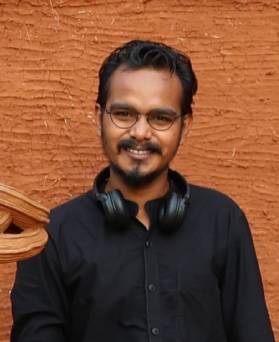
Subham Sahu
Sound from the Ground (The Vocals of My Land) is a project rooted in the cultural identity of western Odisha, a region deeply shaped by indigenous knowledge systems and sustainable ways of life. Subham aims to reintroduce and celebrate the region’s rich musical and cultural heritage for the younger generation, while honouring the knowledge and traditions of the older one.
The project proposes the creation of an archive space—a living repository that brings together photographs, audio-visual materials, folk instruments, small sculptures, maquettes, and drawings. This archive will document and preserve the indigenous musical traditions of Subham’s native region, based on over a decade of collection and engagement from 2010 to 2025. By inviting local folk musicians to perform and use the instruments from his collection, Subham envisions the space as one of active participation and intergenerational dialogue. As both tribute and bridge between traditions and time, the project seeks to inspire younger artists and audiences to engage with their cultural roots, encouraging new creative explorations in music and art that are grounded in local tradition.
Subham hails from the western part of Odisha. He completed his Master’s degree in Sculpture from M.S. University of Baroda, Gujarat, in 2023, and his Bachelor’s degree from KCAC, Sundargarh, Odisha, in 2021. His visual practice explores the relationship between self and cultural environment, aiming to rephrase the regional histories of his native place through natural forms, sounds, archives, and found objects. He has participated in several exhibitions and residencies, including Khoj and Arthashila Residency, Bihar (2025); Shores of Serenity – Chilika Residency by Dot Line Space, Mumbai (2024); Kochi Student Biennale (2022–23); Art for Hope Grant (2024–25); and the Lalit Kala Akademi National Research Grant (2022–23).
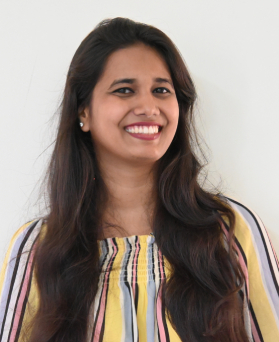
Sarika Goswami
“At the edge of the forest, the world begins to whisper forgotten stories.”
Positioning a gentle lens into shifting landscapes and fragile ecologies in Chattisgarh, Sarika’s project, Edge of the Forest, seeks to document endangered species, sacred trees, and traditional ecological knowledge through collaborative research, observation, and ongoing dialogue with local communities. Invoking different forms of public engagement, the project is an attempt to rebuild conversations around ecological consciousness as a counter to ongoing extractive logics in the state.
Drawing on indigenous techniques such as lipai, craft-making sessions around Hathona and Bahiri knotting as well as film screenings and art workshops, Sarika intends to convene with communities around site-specific engagements to create visual testaments that weave together memory and oral narratives to serve as both archive and expression, commemorating remembered relationships with the forest. These acts of collective making and storytelling become quiet forms of resistance and reclamation—foregrounding continuity, care, and alternate futures shaped by the knowledge of those who live closest to the land.
Sarika Goswami is an interdisciplinary artist whose practice explores the transformation of landscapes through an anthropological and community-based lens. A postgraduate in Fine Arts from the Maharaja Sayajirao University of Baroda, she is currently based between Chhattisgarh and Odisha. Her work has been featured in exhibitions and residencies including Utsha Residency, Bhubaneswar (2025) and a curated show at Conflictorium, Raipur (2025). She is a recipient of the Prafulla Dhanukar Award (2024), the Art for Hope Grant (2023), and the Lalit Kala Akademi Award (2021–22).
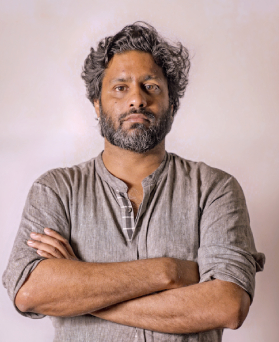
Wenceslaus Mendes
Goa Water Stories 2.0 {‘Hydro-Aqua Futurism’} is an artistic and immersive learning framework for an interdisciplinary cohort, spanning six months through a blend of classroom and site-specific interventions. The programme explores water in Goa through a mapping of spaces, communities, conservation practices, and mythologies, fostering a critical understanding of its ecological and cultural significance. Fieldwork, as imagined within the scope of this project, identifies current environmental crises, community needs, and systemic gaps. Through a non-extractive, play and exploratory process, participants co-create tangible outcomes – both individually and collectively, encouraging holistic problem-solving and the articulation of syncretic, speculative futures in response to ecological challenges. Rooted in solar punk-inspired ecological post-humanism, the initiative aims to build narratives, actions, and objects of resilience, grounded in praxis, culminating in the emergence of a speculative ‘Hydro-Aqua Futurism’ centred on water, ecology, sustainability, and inclusive futures.
Wenceslaus Mendes is a filmmaker, artist, and independent researcher working across multimedia as a cinematographer and editor. His practice is rooted in indigenous communities, exploring land, water, sustainability, and climate change through documentation of oral cultures and ethno-technologies. He engages with the politics of food, consumption, and knowledge through sensory experiences. His research intersects race and caste in India, examining discrimination, segregation, labour, and the Indian prison system. For him, indigenous and local knowledge are critical to inclusive, sustainable futures. His collaborative method—co-labour-abling—builds work in conversation with communities, ecosystems, and the environments from which it emerges.
Photo Credit: Maria Outtakes
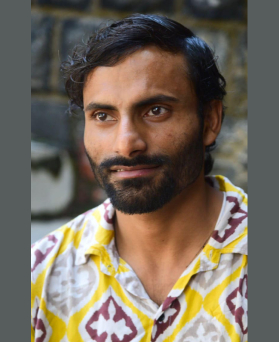
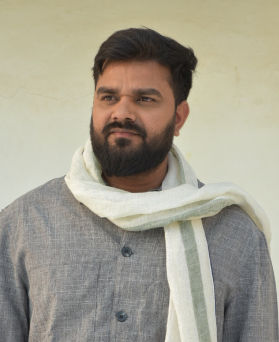
Gyanwant Yadav and Umesh Singh
Presenting a research-led, community-focused initiative along the Yamuna floodplains in Delhi, Gyanwant and Umesh seek to highlight the severe pollution and ecological neglect faced by the river. Migrant farmers, primarily from Uttar Pradesh and Bihar, cultivate the nutrient-rich floodplain soil without formal land rights, and face constant threats of eviction, along with other ecological issues. Taking off from their own preoccupations with the agrarian as a site of enquiry, the artists intend to address these challenges by immersing themselves in the habitat of the Yamuna. They will work to construct a multifunctional, public engagement structure to serve as a shelter, archive, and sanctuary, streamlining its possibilities as a space for gathering, recreation and awareness building on indigenous agricultural practices and sustainable living. By living and working alongside the community, the project will document environmental changes, promote ecological resilience, and advocate for the rights and recognition of informal farmers through a blend of research, art, and activism.
Gyanwant Yadav is a visual artist based in New Delhi. He holds a BFA and MFA from the College of Art, Delhi University. His multidisciplinary practice explores ecological transitions, rural-urban dynamics, and socio-political issues through installations, performance, and mixed media. He has exhibited widely at Birla Academy, Emami Art, and has received the Inlaks Fine Art Award (2023), Experimentor Generator 2024, and Hyundai Art for Hope Grant (2025).
Umesh S is a Varanasi-based visual artist exploring agrarian metaphors and social hierarchies rooted in his rural upbringing. With a BFA from Banaras Hindu University and MFA from the University of Hyderabad, his work reflects on land, labor, caste, and environment. He has participated in residencies including Khoj Peers and Arthshila X Khoj, and exhibited at India Art Fair 2025, Serendipity Festival, and more. His accolades include the Tata Trust International Award in the Students Biennale 2019.

